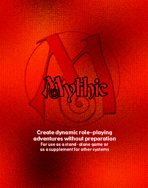Well half of a review. I'm going to look at Mythic as a tool for solo play. I really hadn't heard about Mythic as a system until I ran into an intriguing post over at Tabletop Diversions. Where he his playing out a solo game. My interest in solo gaming is based on my once a month or less group's schedule (I'll be the one missing this month, so no Alesmiter Expedition writeup) and as I'm scheduled to take over as DM, I wanted to try solo questing as a means to flesh out the NPCs and the campaign setting.
 |
| Blue River, Costa Rica |
Enough preamble, on to the review!
Mythic, by Tim Pigeon, is a self contained system advertising the ability to be used for any genre, stand alone or with any other RPG or combination of RPGs. It's a reasonably slim 146 pages, including covers. But that's a bit misleading, after taking out charts, examples of play and the copious illustrations, the rules only comprise about half it's length. And two thirds of those deal with character creation and advancement.
Character creation, which I admit to only skimming, is a point buy system, with the players adding arbitrary strengths and weaknesses as they seem appropriate. To me, that seems easy to use for power gaming, only give your character strengths. But I really have no intention of using the character rules.
I have to say that it's a very sparse system, the basic concept is that everything can be given relative ranks. Relative to what, well Tim says relative to 'average' - which to someone with a background in Six Sigma and a lot of experience in computers doesn't really define it. Essentially the ranks are an dimensionless scale distributed around a point. If the scale is distributed symmetrically around the point, then it can be said to be relative to the average. However there is no hard and fast requirement to have a scale distributed evenly around a point - in fact most measurement scaless in RPGs start from 0 or 1, even those such as character abilities which we roll up on a 3d6 bell curve are really open ended linear scales.
That's all a bit of a quibble, as it doesn't affect gameplay. In fact, Mythic's scales allow you to compare percentile and 3d6 distributions head to head by using the conversions that have been helpfully provided. These impose a dimension on each rank in the scale. Now these aren't mathematically accurate comparisons as a Mythic score of 'Awesome' equates to a 3d6 score of 18 or a percentile score of 96-100, while in reality you have a not quite one half of one percent chance of rolling an 18 (1 in 216). Fudging the numbers this way doesn't bother me, it's a game mechanic and it's internally consistent .
Mythic also ranks the odds of an event occurring on a similar scale, this time ranging from 'Impossible' to 'Has to be'
When you really need them the most, million-to-one chances ALWAYS crop up. Well known fact. - Sgt Colon. Guards! Guards! , Terry Pratchett
The truly inspired part of using dimensionless scaling, is the Fate Chart Tim built which allows you to look at any dimensioned attribute, skill or other factor, equate it with a rank on the scale and determine the odds of succeeding in a head to head contest or in succeeding against the odds with a single percentile roll.
The large number in the cell is the value you need to roll under for a 'Yes', the smaller numbers which equate to the bottom and top 20% based on the 'Yes' value are 'Exceptional Yes' if you roll within the bottom 20% - indicating wild success at your endeavor and 'Exceptional No' if you roll in the top 20% - meaning "R'uh r'oh Shaggy this is going to hurt."
I'll cover how the Fate Chart and other concepts are used in a subsequent post.




No comments:
Post a Comment